Market Trends of Interspinous Spacers Industry
This section covers the major market trends shaping the Interspinous Spacers Market according to our research experts:
Lumbar Spinal Stenosis Segment is Expected to Dominate the Market
Lumbar spinal stenosis is a narrowing of the spinal canal, compressing the nerves traveling through the lower back into the legs. While it may affect younger patients due to developmental causes, it is more often a degenerative condition that affects people who are typically aged 60 and older. The high prevalence and advancing technology of lumbar spinal stenosis and its management are boosting the growth of the segment. According to JAMA Patient Page, in May 2022, over 11% of elderly adults in the United States have the condition of Lumbar spinal stenosis. According to a study published in the Journal of Pain Research in April 2022, interspinous spacers are highly studied for clinical research and scientific studies for the management of lumbar spinal stenosis by reducing pain, improving mobility, and reduction in the use of opiates. The study has recommended the use of interspinous spacers for mild-to-moderate spinal lumbar stenosis.
The players in the market have received approval for their advanced products for the management of lumbar spinal stenosis. For instance, in July 2022, Aurora Spine Corporation received FDA clearance for its ZIP family of MIS implants for the management of lumbar spinal stenosis. The ZIP implant spacer has no screw and is minimally invasive, which bears an edge over traditional surgeries and other interventional procedures.
Therefore, the lumbar spinal stenosis segment is expected to witness significant growth over the forecast period due to the abovementioned factors, including its high prevalence and advancing technology.

North America is Expected to Dominate the Interspinous Spacers Market
North America is expected to dominate the market owing to factors such as the vast geriatric population and high healthcare expenditure. The geriatric population in the region is expanding and is susceptible to spinal stenosis; thus, the aging population drives the growth of the market in the region. According to Statistics Canada, in April 2022, over 861,000 people in Canada were estimated to be aged 85 and above in the 2021 Census, representing over 2.3% of the total population, which shows that the age group population base has doubled from 2001. The age group of 85 years and above was the fastest growing in 2021, with a growth rate of 16% from 2016 to 2021. However, the region also has well-developed healthcare systems and also spends huge amounts in research and development for the same. As a result, most of the global treatments are available in this region. According to the Research Portfolio Online Reporting Tools (RePORT), in May 2022, over USD 185 million had been spent on the research/ disease area of traumatic head and spine injury in 2021. This expenditure was estimated to increase to USD 325 million in 2022 and further to USD 337 million in 2023. According to the Canadian Institute for Health Information (CIHI), in November 2022, Canada spent over CAD 331 million on healthcare (CAD 8,563 per Canadian) in 2022. Hence all these factors have helped many global players to make their presence in this region. As a result, the market has grown and is also expected to grow in the future. Therefore, owing to the previously mentioned factors, the growth of the studied market is anticipated in the North America Region.


